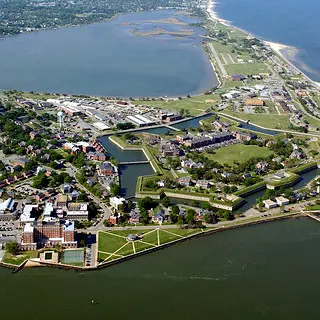
African American Cultural Heritage Action Fund
Fort Monroe National Monument
For almost 200 years, the U.S. Army was a good steward of Fort Monroe, but the transition to its new civilian use requires intensive planning to ensure that the fort is carefully preserved and skillfully adapted. The Fort Monroe Authority is leading the way. On November 1, 2011, President Barack Obama named the fort a National Monument—a key strategy to preserve the fortress with the National Park Service.

photo by: Patrick McKay
The stone walls and moat of Fort Monroe.

photo by: Patrick McKay
The Old Point Comfort Lighthouse on Fort Monroe.

photo by: Patrick McKay
The bridge and entry portal into Fort Monroe.
Fort Monroe has long been recognized for its military heritage associated with Robert E. Lee (who helped build the fort) and Jefferson Davis (who was imprisoned there following the war). But the fort has an under-appreciated heritage related to the origins and ending of slavery in America. In 1619, the first slave ship to arrive in the English-speaking New World deposited its cargo of captive Africans, enslaved by the Portuguese and then taken by English privateers to the British Colonies at Point Comfort, where Fort Monroe now stands.
In 1861, as the Civil War raged, Shepard Mallory, Frank Baker, and James Townsend—enslaved African Americans—sought protection at Fort Monroe, a Union stronghold. Union General Benjamin Butler declared them “contraband” of war. As word spread of the freedom seekers at Fort Monroe, more than 500,000 enslaved people followed in the footsteps of Mallory, Baker, and Townsend, leading to one of our nation’s most extraordinary—and until now, overlooked—chapters, and heralding the end of slavery in America.Campaign Goals
- Prepare and implement detailed plans for conserving Fort Monroe’s outstanding scenic, natural, architectural, and cultural assets.
- Encourage sustainable economic development strategies so that Fort Monroe remains a vital community where people live, work, and visit.
Success!
Under a proposed $23 million deal, Virginia would have seven years to complete infrastructure projects, which would improve the Army facilities at Fort Monroe, a principal landmark of African-American heritage, and the surrounding community.
Visit Fort Monroe National Monument.
Plan Your VisitSupport our work to save places that matter.
DonateStay connected with us via email. Sign up today.
Related Stories
-
Preservation Magazine At These Five Coffeehouses, Small-Business Owners Embrace Their Historic Locations -
Preservation Magazine A Reimagined Library Opens the Cover of Fort Monroe's Black History
Explore More Places
Join us in protecting and restoring places where significant African American history happened.
Learn More



